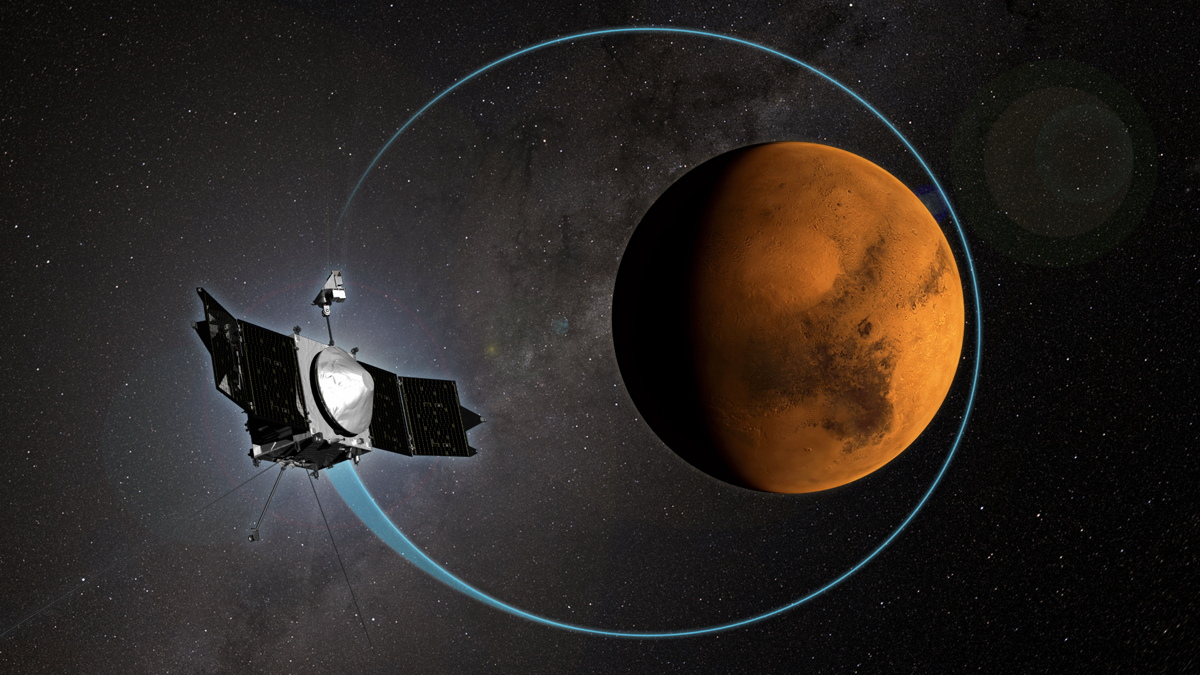NASA Mars Probe Marks One Year at Red Planet

NASA's newest Mars probe has now been circling the Red Planet for a year.
The Mars Atmosphere and Volatile EvolutioN (MAVEN) spacecraft arrived in orbit around the Red Planet on Sept. 21, 2014, 10 months after blasting off from Florida's Cape Canaveral Air Force Station.
MAVEN endured a two-month checkout phase on orbit and then began studying Mars' atmosphere, in an attempt to determine how fast the planet's air is escaping into space. Such information will help researchers better understand how and when Mars shifted from a relatively warm and wet world in the ancient past to the cold and dry planet it is today, NASA officials have said. [NASA's MAVEN Mission to Mars: 10 Surprising Facts]
Everything is going well so far with the $671 million mission, and all of MAVEN's systems and instruments are in good shape, team members said.
"We're obtaining an incredibly rich data set that is on track to answer the questions we originally posed for MAVEN and that will serve the planetary science community for a long time to come," MAVEN principal investigator Bruce Jakosky, of the University of Colorado's Laboratory for Atmospheric and Space Physics in Boulder, said in a statement.
MAVEN's first year at Mars has been quite eventful. In October 2014, for example, the spacecraft survived the close approach of Comet Siding Spring, which zoomed within just 87,000 miles (139,500 kilometers) of the Red Planet's surface.
Observations by MAVEN, NASA's Mars Reconnaissance Orbiter (MRO) and Europe's Mars Express spacecraft revealed that dust and other material shed by the comet created a temporary layer high up in the Red Planet's atmosphere.
Breaking space news, the latest updates on rocket launches, skywatching events and more!
MAVEN has also spotted auroral displays — similar to the northern and southern lights here on Earth — that penetrate surprisingly deeply into the Martian atmosphere and discovered a strange dust cloud that extends from about 93 miles (150 km) above the planet's surface to an altitude of 190 miles (300 km).
The spacecraft can also serve a relay function, helping link up communications between NASA's Opportunity and Curiosity rovers and their handlers on Earth.
MAVEN's primary, one-year mission will end this November, but NASA has extended the probe's operations through at least September 2016.
MAVEN, MRO and Mars Express are three of five operational spacecraft currently studying the Red Planet from orbit. The others are NASA's Mars Odyssey probe and India's first-ever Red Planet spacecraft, which is known as Mangalyaan. Mangalyaan marks its one-year Mars anniversary tomorrow (Sept. 24).
Follow Mike Wall on Twitter @michaeldwall and Google+. Follow us @Spacedotcom, Facebook or Google+. Originally published on Space.com.

Michael Wall is a Senior Space Writer with Space.com and joined the team in 2010. He primarily covers exoplanets, spaceflight and military space, but has been known to dabble in the space art beat. His book about the search for alien life, "Out There," was published on Nov. 13, 2018. Before becoming a science writer, Michael worked as a herpetologist and wildlife biologist. He has a Ph.D. in evolutionary biology from the University of Sydney, Australia, a bachelor's degree from the University of Arizona, and a graduate certificate in science writing from the University of California, Santa Cruz. To find out what his latest project is, you can follow Michael on Twitter.
